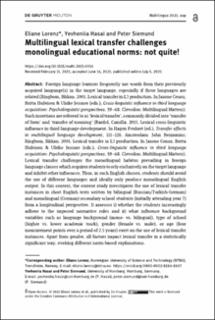| dc.description.abstract | Foreign language learners frequently use words from their previously acquired language(s) in the target language, especially if these languages are related (Ringbom, Håkan. 2001. Lexical transfer in L3 production. In Jasone Cenoz, Britta Hufeisen & Ulrike Jessner (eds.), Cross-linguistic influence in third language acquisition: Psycholinguistic perspectives, 59–68. Clevedon: Multilingual Matters). Such insertions are referred to as ‘lexical transfer’, commonly divided into ‘transfer of form’ and ‘transfer of meaning’ (Bardel, Camilla. 2015. Lexical cross-linguistic influence in third language development. In Hagen Peukert (ed.), Transfer effects in multilingual language development, 111–128. Amsterdam: John Benjamins; Ringbom, Håkan. 2001. Lexical transfer in L3 production. In Jasone Cenoz, Britta Hufeisen & Ulrike Jessner (eds.), Cross-linguistic influence in third language acquisition: Psycholinguistic perspectives, 59–68. Clevedon: Multilingual Matters). Lexical transfer challenges the monolingual habitus prevailing in foreign language classes which requires students to rely exclusively on the target language and inhibit other influences. Thus, in such English classes, students should avoid the use of different languages and ideally only produce monolingual English output. In this context, the current study investigates the use of lexical transfer instances in short English texts written by bilingual (Russian/Turkish-German) and monolingual (German) secondary school students (initially attending year 7) from a longitudinal perspective. It assesses i) whether the students increasingly adhere to the imposed normative rules and ii) what influence background variables such as language background (mono- vs. bilingual), type of school (higher vs. lower academic track), gender (female vs. male), or age (four measurement points over a period of 2.5 years) exert on the use of lexical transfer instances. Apart from gender, all factors impact lexical transfer in a statistically significant way, evoking different norm-based explanations. | en_US |

